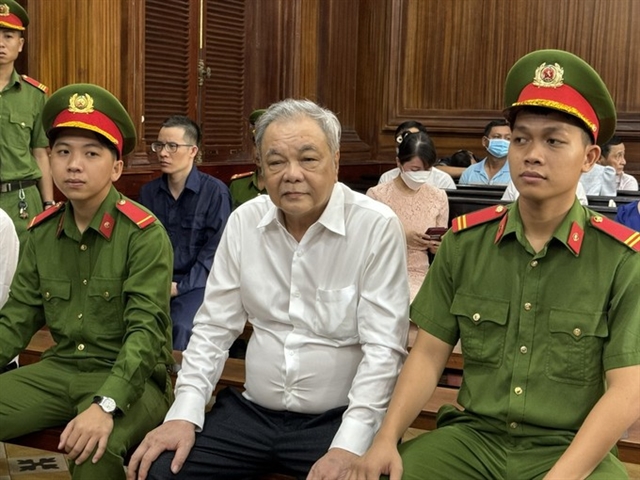 Opinion
Opinion

Dương Văn Cận, Vice Chairman and General Secretary of the Việt Nam Association of Construction Contractors (VACC) tells Thời báo Kinh tế Việt Nam (Vietnam Economic Times) about measures to settle outstanding debts in infrastructure construction which is estimated to reach between VNĐ30-40 trillion (US$1.33-1.77 billion).
 |
| Dương Văn Cận |
Dương Văn Cận, Vice Chairman and General Secretary of the Việt Nam Association of Construction Contractors (VACC) talks to Thời báo Kinh tế Việt Nam (Vietnam Economic Times) about measures needed to settle outstanding debts in infrastructure construction, estimated at between VNĐ30-40 trillion (US$1.33-1.77 billion).
What is the current situation regarding outstanding debts in infrastructure construction?
Outstanding debts in infrastructure construction across the country have been a problem for many years at different levels, leading to incomplete or delayed projects and low investment efficiency.
The outstanding debts are not only found in contract packages using capital from the State Budget and Government bonds, but in projects using capital from all other sources.
The situation arises when investors do not meet capital requirements and prolong payment to contractors, or when investors intentionally drag out the work and appropriate investment capital, but fail to pay contractors.
An estimated of VNĐ30-40 trillion worth of outstanding debt in infrastructure construction has been recorded so far, according to our estimates.
The debt terms vary. Some projects have debts lasting for decades.
Is it true that current regulations are not strong enough to deal with this issue?
The Government has issued many directives and measures for early settlement of these debts, including one issued in October 2012 to enhance management of investment and handling of debts in projects funded by the State Budget and Government bonds.
Under this directive, the Prime Minister asked localities to prioritise allocation of capital for settling outstanding debts using the local budget.
Later, in 2013, the Prime Minister issued another directive to strengthening financial management of the State budget with particular focus on handling outstanding debts in infrastructure construction projects
In 2014, the PM set a target to basically pay for infrastructure construction debts by December that year, asking all relevant ministries, agencies and sectors to resolutely implement regulations of the Law on Public Investment to prevent any infrastructure construction outstanding debts accruing from 2015 onwards.
In April, 2015, yet another directive called for intensified application of measures to settle outstanding debts in capital construction, requesting ministries, sectors and localities to strictly control the formulation, appraisal and approval of investment plans and decisions with regard to public investment projects.
This directive also enhanced the responsibility of competent agencies performing formulation, appraisal and approval tasks. They were asked not to approve investment plans and decisions in case capital sources and capacity remained uncertain, or capital investment exceeded the level evaluated by competent agencies.
These legal documents show the Government’s determination on handling long-standing issues in construction investment management.
What are the main reasons that have led to this problem?
There are many reasons. Key reasons include approving investment decisions without clearly defining sources of investment capital or failure to disburse enough capital for construction projects; and approving investment projects that are not in the list of sectors’ development plans.
Some projects have had to be amended, leading to an increase in investment capital.
The practice of projects beginning implementation before identifying sufficient capital sources continues in many areas.
What are the association’s suggestions for dealing with this problem?
Under the 2014 Construction Law, it is not compulsory to appraise investment capital sources when appraising a project’s feasibility. This gap should be addressed with a provision in the Bidding and Construction laws requiring investors to guarantee payment.
The Construction Law should also have punitive measures for investors delaying payment to contractors.
The Government should entrust relevant ministries and agencies to calculate, appraise and classify outstanding debts in infrastructure construction so that there is a rational priority list to deal with them and ease difficulties faced by contractors. — VNS
INBOX
Phạm Văn Khánh, Head of the construction ministry’s Department of Economy
Stakeholders in all infrastructure construction should improve their contract management capacity. In fact, many consultants, contracts and investors have limited capacity and lack legal knowledge, so they fail to manage contracts in line with State regulations, thus leading to outstanding debts. A construction project is affected by many factors and it requires stakeholders to thoroughly understand related laws, construction markets and other issues to prevent any shortcomings arising in the process of formulationg projects, estimating costs and signing contracts.
Lê Doanh Yên, Deputy Director General of Vietnam Construction and Import-Export Joint Stock Corporation (Vinaconex)
Handling outstanding debts in construction must be considered an important part of public investment restructuring and one of several solutions to help stabilise the macro economy and ensure sustainable economic growth. Relevant ministries and agencies have to balance their capital sources and resolutely handle outstanding debts in construction projects. They should proactively assess the efficiency, level of completion and exploitation capacity of each project to minimise losses caused by projects that cannot be completed due to outstanding debts.
Nguyễn Xuân Bắc, Head of the State Bank of Việt Nam’s Office of Credit for Industry and Construction Sectors
The legal system in the banking sector is complete and allows commercial banks to issue payment guarantees on behalf of investors to contractors. However, the problem is how to insert this guarantee aspect into construction contracts between investors and contractors. This depends on negotiations between the two sides.
The State bank of Vieät Nam will closely work with the Construction Ministry to research and provide advice on finalising related mechanisms and policies to contribute to settling outstanding debts in infrastructure construction. — VNS









